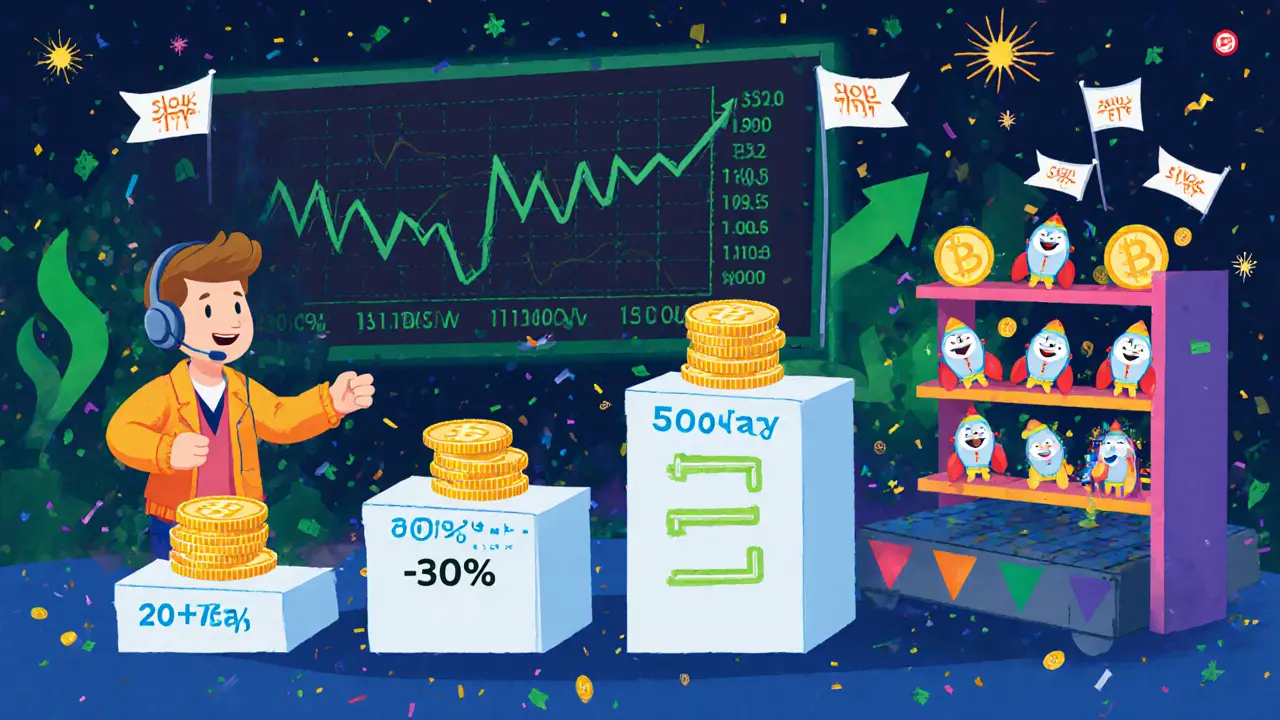Crypto Market Mood Detector
Bull Market
Characterized by rising prices, high confidence, and strong buying pressure.
Bear Market
Characterized by falling prices, low confidence, and heavy selling pressure.
Market Condition Analyzer
Select the current market indicators to determine if the market is in a Bull or Bear phase.
Market Analysis Result
Recommended Strategy:
When people talk about Bull and Bear Markets in Cryptocurrency the alternating up‑ and down‑trends that characterize crypto price cycles, influencing investor behavior and market dynamics, they’re really describing the two main moods that decide whether prices are sprinting upward or sliding downward. Knowing which mood you’re in can mean the difference between riding a wave and getting wiped out.
Quick Takeaways
- A bull market is a sustained period of rising crypto prices, usually driven by strong buying pressure and optimism.
- A bear market is a prolonged drop in prices, marked by heavy selling, low confidence, and reduced trading activity.
- In crypto, a 20% move signals a phase shift, but swings of 40% or more in a single day are common during bull runs.
- Key tools to spot the shift: Crypto Fear & Greed Index, trading volume spikes, and price trend lines.
- Different strategies work best in each phase - profit‑taking and scaling out in bull markets, dollar‑cost averaging and project research in bear markets.
What Is a Bull Market in Crypto?
A bull market in cryptocurrency is a period where the majority of participants are buying, demand outstrips supply, and confidence climbs to high levels. Prices don’t just inch up; they can jump 40% in a day or more, especially for altcoins that are smaller than Bitcoin. The rise starts when early investors notice a price uptick, hop in, and create a feedback loop - more buying fuels higher prices, which attracts even more buyers.
Two practical signals point to a bull phase:
- Sentiment gauge: The Crypto Fear & Greed Index an aggregated score that measures market optimism versus fear often climbs above 60, indicating greed.
- Volume surge: Trading volume on major exchanges can double or triple the average, showing that money is flowing in.
During a bull run, media coverage turns hyper‑positive, influencers flood social channels with “buy now” messages, and new projects see a flood of funding. The environment feels like a party - everyone wants a slice of the rising pie.
What Is a Bear Market in Crypto?
A bear market flips the script. Prices fall sharply - often 50% to 90% from recent highs - and stay low for weeks, months, or even years. Selling pressure dominates, confidence sinks, and most participants adopt a wait‑and‑see stance. Trading volume dries up as traders sit on the sidelines.
The December 2017 crash is a textbook example: Bitcoin slipped from nearly $20,000 to under $7,000 in weeks, while many altcoins lost 70% or more of their value. When the market turns bearish, the tone of news articles shifts from “crypto is the future” to “crypto is risky.”
Key bear‑market traits include:
- Sharp price declines of at least 20% sustained over several weeks.
- Trading volume drops to a fraction of its bull‑run levels.
- Project development slows, and media coverage becomes skeptical.
- Scams and weak projects often collapse, leaving only the stronger fundamentals.
How to Spot the Transition
Detecting the switch from bull to bear (or vice‑versa) early can protect your capital. Here are three practical checkpoints you can monitor daily:
- Sentiment divergence: When the Fear & Greed Index tops out (above 80) and then starts slipping while price still climbs, a reversal may be looming.
- Volume patterns: A sudden drop in volume after a prolonged surge often signals that buying enthusiasm is waning.
- Technical breakouts: A break below a well‑tested support line (for example, the 200‑day moving average) backed by falling volume is a classic bear‑signal.
Combine these clues with macro events - regulatory announcements, major exchange hacks, or large institutional inflows - to improve accuracy.
Strategies for Bull Markets
When the market is roaring, the goal shifts from “survive” to “capitalize.” Here are three tactics that work well:
- Profit‑taking ladders: Set tiered exit points (e.g., sell 25% at +30%, another 25% at +60%, rest at +100%). This locks in gains while keeping a position for further upside.
- Trend‑following entries: Use moving‑average crossovers (e.g., 20‑day crossing above 50‑day) to jump into new rallies early.
- Allocate to high‑growth altcoins: During bull runs, altcoins often outpace Bitcoin’s gains. Do your research, but a small, controlled exposure can boost returns.
Remember, bull markets can turn quickly. Keep stop‑loss orders or trailing stops to protect against sudden reversals.

Strategies for Bear Markets
In a downtrend, patience and risk management become paramount. Consider these approaches:
- Dollar‑cost averaging (DCA): Dollar‑cost averaging a method of investing a fixed amount at regular intervals, reducing the impact of volatility lets you build a position slowly as prices dip.
- Focus on fundamentals: Look for projects that keep development active, have strong teams, and maintain community engagement despite the gloom.
- Stablecoin parking: Move a portion of your portfolio into stablecoins to preserve capital while you scout for buying opportunities.
Bear markets also offer a chance to study chart patterns, hone research skills, and prepare for the next bull phase.
Bull vs Bear: Quick Comparison
| Aspect | Bull Market | Bear Market |
|---|---|---|
| Price Trend | Sustained upward movement, often >20% weekly | Prolonged decline, typically >20% from peak |
| Investor Sentiment | Optimism, greed (Fear & Greed Index >60) | Pessimism, fear (Index <40) |
| Trading Volume | High, spikes precede rallies | Low, many traders sit on sidelines |
| Media Tone | Positive headlines, hype around new projects | Critical coverage, focus on crashes |
| Typical Strategy | Profit‑taking ladders, trend‑following, altcoin exposure | DCA, fundamentals focus, stablecoin parking |
| Risk Level | Higher - rapid reversals possible | Lower - prices already depressed, but patience needed |
Real‑World Example: Bitcoin’s 2022‑2023 Cycle
Bitcoin (BTC the leading cryptocurrency, often used as a market benchmark) peaked around $68,000 in November 2021. By June 2022, it slipped below $20,000 - a classic bear phase lasting over a year. Trading volume dropped sharply, and the Fear & Greed Index fell into the “fear” zone. During the subsequent bull resurgence in late 2023, volume surged, the index swung to “greed,” and Bitcoin rallied back above $40,000, illustrating how the two phases cycle repeatedly.
Regulatory Influence
Regulation can act as a catalyst for both phases. Positive news - such as a major jurisdiction approving crypto‑friendly rules - often triggers a bull spike. Conversely, harsh crackdowns or bans can accelerate a bear downturn. Keeping an eye on policy announcements (e.g., from the U.S. SEC, EU MiCA regulation, or Australian ASIC) helps you anticipate sudden sentiment swings.
Institutional Participation
Institutional money has grown since the 2017 crash. When hedge funds or public companies allocate capital to crypto, they bring liquidity and legitimacy, nudging the market toward a bull stance. In bear markets, many institutions step back, leaving the field to retail traders and long‑term believers.
Preparing for the Next Cycle
Regardless of the current mood, a sound plan includes:
- Defining a risk budget (e.g., never risk more than 2% of total capital on a single trade).
- Monitoring the Fear & Greed Index and volume trends weekly.
- Keeping a list of high‑quality projects to DCA into during bear dips.
- Setting clear profit targets and stop‑loss levels for bull runs.
By treating bull and bear markets as predictable cycles rather than anomalies, you can stay calm, act strategically, and ultimately improve your crypto returns.

Frequently Asked Questions
How long does a typical crypto bull market last?
Historically, bull runs in crypto have spanned 12 to 18 months from the first sustained price rise to the peak, though exact timing varies with market size and external events.
Can I safely hold crypto during a bear market?
Holding through a bear market can be profitable if the assets you own have strong fundamentals. Many long‑term holders see 200%+ gains after the next bull cycle.
What role does the Crypto Fear & Greed Index play?
The index aggregates data on volatility, market momentum, social media sentiment, and dominant‑coin trends. Scores above 60 usually signal bull‑ish conditions, while below 40 hint at bear‑ish pressure.
Is dollar‑cost averaging effective in a bear market?
Yes. By investing a fixed amount regularly, you buy more when prices are low and less when they rise, smoothing out volatility and lowering the average cost basis.
Do regulations trigger bull markets?
Positive regulatory news-such as clear guidelines or institutional‑friendly policies-often sparks optimism, drawing new capital and igniting a bull rally.


WILMAR MURIEL
Understanding the difference between bull and bear markets is crucial for any crypto trader, especially when volatility seems to be the norm nowadays. A bull market, as the article describes, is characterized by rising prices, strong buying pressure, and an overall optimistic sentiment among investors. This environment often encourages newcomers to jump in, hoping to catch the upward wave before it peaks. However, it’s important to remember that such optimism can sometimes be misplaced, leading to over-leverage and eventual disappointment. On the other hand, a bear market signals falling prices, low confidence, and heavy selling pressure, which can be intimidating for both veterans and beginners alike. The fear that permeates a bear phase can cause panic selling, often driving prices even lower than fundamentals would suggest. Yet, a bear market also presents opportunities for strategic accumulation at discounted levels, provided you have a solid risk management plan. One key strategy during bullish phases is to employ profit‑taking ladders, gradually securing gains as the price climbs rather than trying to time the absolute top. In bear markets, setting tight stop‑losses and focusing on high‑quality projects with real utility can protect your capital. Additionally, monitoring volume trends can offer insights: high volume in a bull market confirms strength, while unusually high volume in a bear market might indicate capitulation, a potential sign of an upcoming reversal. Diversifying across assets and not putting all eggs in one basket is another timeless principle that applies regardless of market mood. Remember that sentiment indexes, such as the Fear & Greed Index, are useful but not infallible, so combine them with on‑chain metrics and fundamental analysis. Position sizing is essential; never risk more than a small percentage of your portfolio on a single trade, especially in unpredictable crypto markets. Patience is a virtue during both phases: in bull markets, waiting for the right entry point can improve returns, while in bear markets, waiting for confirmation before re‑entering can prevent costly mistakes. Finally, keep educating yourself, as market dynamics evolve, and the strategies that worked last year may need adjustments today.